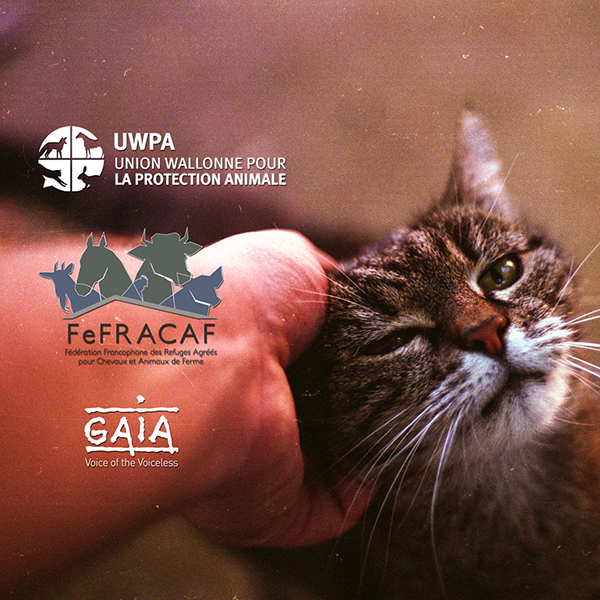Stray cats in Wallonia: UWPA, FeFRACAF and GAIA raise a cry of alert
"For Minister Céline Tellier, must stray cats starve to death?"

Tuesday April 21, 2020 -
In a joint press release, the Walloon Union for Animal Protection (UWPA), the Francophone Federation of approved shelters for horses and farm animals (FeFRACAF) and GAIA call on the Walloon Minister for Animal Welfare, Ms. Céline Tellier, "to act in extreme urgency ”and to clarify its communication so that the communes can authorize again the feeding, the trapping and the sterilization of the stray cats by the communal staff or the private individuals, and this“ in the maximum respect of hygiene measures ” .
"Minister Tellier authorizes trapping by shelters, but prohibits the feeding of stray cats to individuals.
Which goes totally against animal welfare.
Should we deduce that for her, stray cats can starve? "Says GAIA director Ann De Greef.
In order to avoid any problem of feline overcrowding, the UWPA insists: "It is imperative that the municipal administrations be able to maintain their sterilization and feeding program".
On March 18, 2020, the Federal Minister of Security and the Interior issued an emergency measures order to limit the spread of the COVID-19 coronavirus.
In this decree, the care of animals "which depend on humans for their well-being and their health" constitutes an "essential activity".
However, unlike the Brussels-Capital Region and Flanders who are taking the problem of feline overpopulation at its root, the Walloon Minister of Animal Welfare, Céline Tellier, had decided to suspend trapping, care and feeding stray cats during confinement.
At the insistence of Walloon refuges and associations in the field, as well as GAIA, it finally revised its position by authorizing trapping by refuges and animal protection associations in the Circular of April 6, 2020.
However, the communes and their inhabitants also play a determining role in the management of stray cats.
However, due to a misinterpretation, the new ministerial circular ignores the feeding and sterilization projects of stray cats.
A decision that goes wrong with Walloon refuges and animal rights associations.
A cry of alert from associations and shelters
“Feline overcrowding remains a serious problem in Belgium.
Increasingly aware, several Walloon municipalities have implemented an active policy of sterilization of stray cats, recall the Walloon Union for Animal Protection (UWPA), which brings together 27 Walloon associations and shelters, and the French-speaking Federation of approved shelters for horses and farm animals (FeFRACAF), which represents 10 member associations.
Because of its lack of communication, not only do the security services verbalize individuals who come to the aid of stray cats, but many Walloon municipalities cease their sterilization campaigns, placing this burden on shelters only ”.
Indeed, sterilization remains a necessity to avoid the excess of cats abandoned in shelters and to reduce the overpopulation of unwanted cats.
"This measure is absolutely necessary to put an end to the tragic situation that thousands of cats live every year, namely the multiplication of unwanted kittens and abandoned in droves in shelters, as well as the births of more and more stray cats.
If we let nature take over, we risk destroying all the efforts made so far by the municipalities, shelters and volunteers, "explains GAIA director Ann De Greef. In fact, in the Brussels-Capital Region and in Flanders, the municipalities which do not go directly through shelters or associations, can carry out these activities through the authorization of the mayor.
This should also be the case in Wallonia. "We very much hope that the Walloon Minister for Animal Welfare, Céline Tellier, will come back to her position and quickly follow the example of the other two Regions," concludes Ann De Greef.
And the UWPA to insist: "We ask the Walloon municipalities to take the full measure of this problem and, if it is not already done, to authorize again the feeding, the trapping and the sterilization of the stray cats by the municipal staff or individuals ”.
A necessity
In cats, 1 + 1 = 6, sometimes more than twice a year.
Thus, "let nature take its course" is to give life to 36 cats in the space of 16 months and often amounts to killing them.
In addition, overcrowded shelters can no longer cope with the influx of abandoned or found cats.
Failing to be adopted, they end up being euthanized in shelters or spend their lives wandering in the streets or in nature, most of the time suffering from fatal diseases related to their inbreeding, with the consequences and nuisances resulting for the community.
|